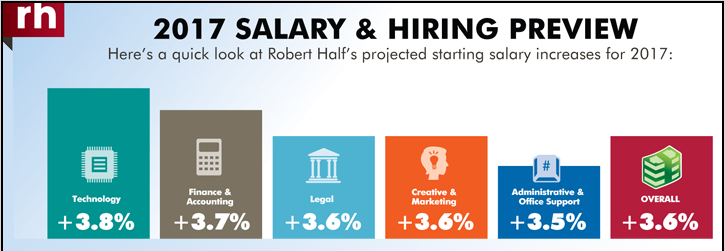Salary Trends for 2017
The lack of skilled IT workers is hurting the deployment of emerging technology, according to a new survey from Gartner. In areas from cloud to cybersecurity, this crisis is expected to last for years to come.

According to
2017 Salary Guides from Robert Half national average starting salaries for
U.S. professional occupations are expected to increase 3.6 percent. The
technology sector leads with a projected 3.8 percent average gain in pay.
The reason
employers are willing to negotiate and pay higher salaries is due to the fact
that IT talent is scarce. According to
Forbes, it is estimated that by 2018 the U.S. will face a shortage of about
224,000 high tech workers.
Though overall shortages are reported there are some positions enjoying a strong demand and these are projected to see even greater salary gains in the coming years. These positions include:
·
Network
security engineers,
·
Data
scientists and
·
Big
data engineers
Project and
consulting opportunities in technology, which have become more plentiful in
recent years, are likely to remain steady in 2017.
Advice to Candidates
Even though
it is a job seekers’ market; getting a job still involves proving your
abilities and expertise to the employer. It is important to show a track record
of success. Some of the things that candidates can do to land the job:
·
Clearly
show career progression on your resume
·
Clearly
show proven track record of delivering results for past employers
·
State
how your skills can create value for the company
·
Be
prepared to discuss technical skills in depth
·
Demonstrate
strong soft skills including communication skills
Advice to Employers
“To remain
competitive, especially in the technology and finance fields, it’s crucial to
have a solid understanding of salary trends for specific roles in your area and
move quickly when making offers. Top candidates are receiving multiple job
offers and will lose interest when faced with a lengthy hiring process,” said
Paul McDonald, senior executive director at Robert Half.
Technology Roles In Demand
In the year ahead,
many employers across North America will hire both full-time and contract
professionals in these roles:
·
Developers
(web, software and mobile applications)
·
Business
intelligence analysts
·
Database
administrators
·
Help
desk and desktop support professionals (especially Tiers 2 and 3)
·
Systems engineers and systems administrators
Positions With 4% +
Salary Increase
|
Title |
2016 |
2017 |
% Change |
|
Big Data Engineer |
$129,500 - $183,500 |
$135,000 - $ 196,000 |
5.8% |
|
Database Developer |
$103,250 - $153,250 |
$108,000 - $ 161,500 |
5.1% |
|
Data Architect |
$127,250 - $175,500
|
$131,250 - $ 184,000
|
4.1%
|
|
Data Scientist |
$109,000 - $153,750 |
$116,000 - $ 163,500 |
6.4% |
|
Business Intelligence Analyst |
$113,750 - $164,000 |
$118,000 - $ 171,750 |
4.3% |
|
Front-End Web Developer |
$ 79,750 - $111,250 |
$ 83,250 - $119,500 |
6.2% |
|
Web Designer |
$ 67,000 - $112,250 |
70,500 - $118,000 |
5.2% |
|
Web Developer |
$ 78,500 - $129,500 |
$ 82,750 - $135,500 |
4.9% |
|
E-Commerce Analyst |
$ 88,000 - $129,500 |
$ 92,000 - $135,000 |
4.4% |
|
Network Engineer |
$ 96,000 - $138,750 |
$ 99,000 - $146,250
|
4.5%
|
|
Wireless Network Engineer |
$108,750 - $150,750 |
$113,250 - $158,000 |
4.5%
|
|
Data Security Analyst |
$113,500 - $160,000 |
$118,250 - $169,000 |
5.0%
|
|
Systems Security Administrator
|
$105,500 - $149,500 |
$110,500 - $157,500 |
5.1% |
|
Network Security Administrator |
$103,250 - $147,000
|
$107,750 - $155,250 |
5.1% |
|
Network Security Engineer |
$110,250 - $152,750
|
$115,500 - $162,500 |
5.7% |
|
Information Systems Security Manager
|
$129,750 - $182,000 |
$136,000 - $191,750 |
5.1% |
|
Software Engineer |
$103,000 - $156,250
|
$108,250 - $164,500 |
5.2% |
|
Software Developer |
$ 91,000 - $145,250 |
$ 93,000 - $155,000 |
5.0% |
|
IT Auditor |
$ 95,000 - $144,750 |
$ 98,500 - $ 153,000 |
4.9% |
Share your comments on this Article:(0)
Leave a Reply
